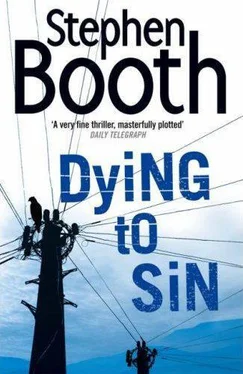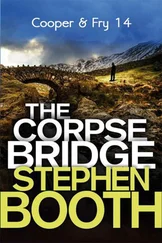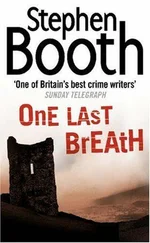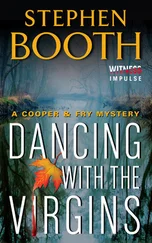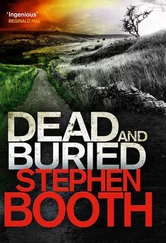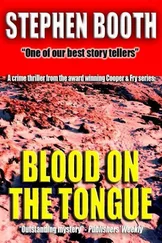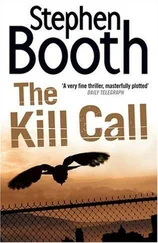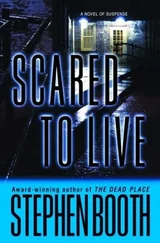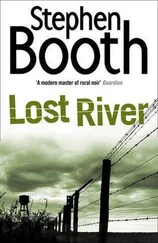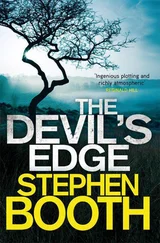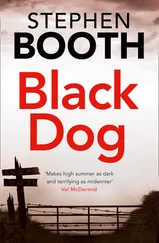Stephen Booth - Dying to Sin
Здесь есть возможность читать онлайн «Stephen Booth - Dying to Sin» — ознакомительный отрывок электронной книги совершенно бесплатно, а после прочтения отрывка купить полную версию. В некоторых случаях можно слушать аудио, скачать через торрент в формате fb2 и присутствует краткое содержание. Жанр: Полицейский детектив, на английском языке. Описание произведения, (предисловие) а так же отзывы посетителей доступны на портале библиотеки ЛибКат.
- Название:Dying to Sin
- Автор:
- Жанр:
- Год:неизвестен
- ISBN:нет данных
- Рейтинг книги:3 / 5. Голосов: 1
-
Избранное:Добавить в избранное
- Отзывы:
-
Ваша оценка:
- 60
- 1
- 2
- 3
- 4
- 5
Dying to Sin: краткое содержание, описание и аннотация
Предлагаем к чтению аннотацию, описание, краткое содержание или предисловие (зависит от того, что написал сам автор книги «Dying to Sin»). Если вы не нашли необходимую информацию о книге — напишите в комментариях, мы постараемся отыскать её.
Dying to Sin — читать онлайн ознакомительный отрывок
Ниже представлен текст книги, разбитый по страницам. Система сохранения места последней прочитанной страницы, позволяет с удобством читать онлайн бесплатно книгу «Dying to Sin», без необходимости каждый раз заново искать на чём Вы остановились. Поставьте закладку, и сможете в любой момент перейти на страницу, на которой закончили чтение.
Интервал:
Закладка:
‘I’ll be all right. I won’t mind being busy.’
Murfin studied him for a moment. ‘Hang on, though. What about Liz?’
‘She’s going home to her own family in Stoke.’
‘And you’re not invited?’
Cooper felt himself starting to get a bit irritated by Murfin’s selflessness. ‘It’s OK, Gavin, really. I want to swap. I’ll do Christmas duty.’
‘Well, all right. Will you tell Miss, or shall I?’
‘I’d better do it, I think. By the way, what are you buying your kids for Christmas, Gavin?’
‘The eldest is really into computer games.’
‘I like The Sims ,’ said Cooper.
‘I’m a bit worried about that one, in case the wife gets hold of it.’
‘Sorry?’
‘Well, they say there’s the thing about women who play The Sims . They use it to exercise their cruel streak, and have fun tormenting small, helpless creatures. They make them live in houses with no toilets. They lock them in rooms with no doors and windows and see how long it takes them to go mad.’
‘Is that so?’
‘If I didn’t know better, I’d think it was designed by our DS.’
No matter how long the morning briefing had been allowed to run on, it would not have been capable of providing a satisfactory conclusion. There was no lucid narrative to the deaths of the two victims at Pity Wood Farm, no story of their lives to give them an identity. Apart from confirmation that they were both female, they still had no humanity.
Every officer present in the room was conscious of the lack of information, the gaping hole in their enquiry, the blockage that was stalling it before it had even got going. No IDs.
Cooper always felt a particular sense of despair at these cases. Of course, there were many people who lived transient lives. They put down their roots in shallow soil. Unnoticed when they arrived, and unmissed when they left.
‘First of all, there’s no evidence of major trauma, no broken bones,’ said Hitchens, getting straight to the main issue. ‘Some poisons might show up in the hair mat that had sloughed off the first victim. But if death was due to injury to the soft tissues, we’re right out of luck.’
‘Parts of the first body looked almost … mummified,’ said someone.
‘That’s adipocere. We don’t see mummified body parts very often in this part of the world — you need a dry, arid climate for that.’
The list of potential evidence dug out by the forensic anthropology team was impressive. During the excavation, they’d packaged up forty-four bones, two dirt samples, twenty-nine bags labelled ‘unknown debris’, fifteen bags of clothing fragments, and seventeen teeth.
‘Yes, they’ve been dead for about a year and four years respectively, we’re told, but neither of them was necessarily killed where they were found,’ said Hitchens. ‘Or even buried there when they first died. Apparently, the scene is right on a geological boundary — the clay on the south side of Pity Wood Farm doesn’t extend into the fields to the north or east. It’s probably why the place was built there in the first place. Historically, I imagine there was a brickworks, or a clay pit.’
‘It’s almost certainly how the farm got its name,’ said Cooper. ‘Pity Wood, because there were several clay pits here, in the woods. Obviously, most of the trees have gone now, too. They would have needed the wood for firing kilns.’
‘What about dental records, sir?’ asked Fry.
‘OK, we have good dentition remaining on the more recent of the two bodies. Enough to confirm an identity from dental records. If we had a potential identity to confirm, of course. But at the moment we haven’t a clue who she is.’
‘Mrs van Doon said there was an unusual amount of decay to the victim’s teeth.’
‘Yes. When I said “good dentition”, I didn’t mean to suggest her teeth were in good condition. I mean we have a good profile of her teeth, and any dental work, plus the unusual condition. This gives us a better chance of making a positive identification.’
‘Understood.’
‘As for the second victim, this individual is also female. What more can I tell you?’
‘There was a shoe,’ said Cooper. ‘That could give us a lead, at least.’
‘But the shoe wasn’t found on the victim, it was lying in the soil about five yards away from the body. Without a direct connection to the victim, it isn’t a known piece of evidence. It could have landed up there some other way.’
Hitchens looked around the group. ‘Now I’m going to hand over to our consultant forensic anthropologist, Dr Pat Jamieson, who is going to fill us in on some of the details.’
Murfin groaned dramatically, as if he’d been shot. Despite himself, Cooper couldn’t help laughing.
‘Superintendent Branagh has expressed a firm view on this,’ said Hitchens, as if he’d anticipated resistance. ‘She thinks we should be fully briefed by the forensic specialists. We ought to make full use of their expertise while we have them on the payroll, so to speak. The superintendent believes we’ll all benefit from the insight.’
Murfin was making noises as though he was going to be sick. Hitchens looked at him.
‘And she emphasized that it should be the whole team.’
When Dr Jamieson entered, he looked as surprised as anyone to be sitting in a meeting room with a bunch of DCs who thought they had better things to do. Cooper wondered who had twisted his arm. The mysterious Superintendent Branagh, perhaps?
Jamieson rallied bravely, despite the chilly atmosphere. He became professional after he’d set up his laptop and screen, and began his presentation.
‘Well, there are four things we might hope to establish from decomposed or skeletalized remains,’ he said. ‘Sex, race, age and stature.’
‘And cause of death?’ suggested someone hopefully.
Jamieson turned to Hitchens. ‘Inspector, you know I can’t address — ’
‘Yes, I know. Carry on, Doctor.’
The anthropologist hesitated. ‘I see. Well, let’s press on. First comes sex.’
He seemed to notice Gavin Murfin’s expression out of the corner of his eye and hastily amended his words.
‘Ah … first comes gender. As a rule, it’s easy to determine gender in adults if the remains include the pelvic bones. The pelvis of a woman is generally broader than that of a man. It has to be wider in females because it surrounds the birth canal, and a baby’s head has to pass between the bones of the pubis. Without the pubis, the probability of making a correct identification of gender declines. Generally it comes down to size differences, but there’s a certain amount of overlap in the middle. There are approximately ten per cent of individuals who confuse the middle ground.’
‘We do have some very large young women walking around Edendale.’
‘It’s not a question of obesity,’ said Jamieson, ‘but of height, the width of the shoulders, the density of the bone …’
‘And in this case …’
‘In both cases, the pelvis was clearly female. It was obvious even in the field. For both Victim A and Victim B, the pelvis is broader at the hips, with a raised sacro-iliac joint, a wide sciatic notch, a greater sub-pubic angle. All part of the geometry of birth. The skull can also be a help, but of course …’
‘We don’t have two skulls.’
‘Not for Victim B. No, we don’t.’
Jamieson paused, allowing for more questions. ‘Now, race is a question we’re often asked to pronounce on. But it’s getting more difficult. Some characteristics of particular populations are evident in the skeleton, but there’s a lot of variation, even within groups that are historically pure. In the case of Victim A, we have the hair mat, which had sloughed off the skull. As you can see from the first picture, it’s very dark brown and slightly wavy. That, plus the shape of the teeth, mark the victim as white, where the discoloured skin might have been misleading.’
Читать дальшеИнтервал:
Закладка:
Похожие книги на «Dying to Sin»
Представляем Вашему вниманию похожие книги на «Dying to Sin» списком для выбора. Мы отобрали схожую по названию и смыслу литературу в надежде предоставить читателям больше вариантов отыскать новые, интересные, ещё непрочитанные произведения.
Обсуждение, отзывы о книге «Dying to Sin» и просто собственные мнения читателей. Оставьте ваши комментарии, напишите, что Вы думаете о произведении, его смысле или главных героях. Укажите что конкретно понравилось, а что нет, и почему Вы так считаете.
